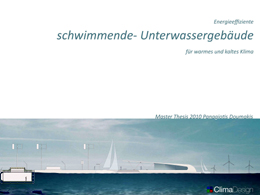STUDENTS PROJECTS
2010

25 January, 2011
Energy Efficient Floating- underwater buildings for Warm & Cold Climates
A Concept about the optimizing of the energy efficiency of floating- underwater buildings as also the calculation of their energy demand and their construction method. A model- floating building is at Copenhagen (Denmark) and at Muscat (Oman) simulated.
Student: Doumakis Panagiotis
Professor : Robert Fröhler- Lehrstuhl für Bauklimatik und Haustechnik TUM, Dr. Gunter Pültz- Müller- BBM
Technical University of Munich
Presentation Date: July 2010

Master/ Thesis Cover

3-d Visualization of LIMANI
Abstract
Demographical, economical, sociological and political reasons force more people to opt a big city as a place to live. The so called Megacities will gather more than 70 % of the world population and the 90% of them are placed near the sea or a river. Cities like New York, Rio de Janeiro, Istanbul, Tokyo or Shanghai are some characteristic examples. Moreover, the rise of the sea levels by 19 - 58 cm according to the IPCC scenario, due to the global warming (of the atmosphere), could lead to catastrophic results for the economic growth of these towns. The most known and actual problem, however, is finding free space in the old- city`s core for the establishment of new uses and functions.

3-d Visualization of LIMANI / interior

3-d Visualizations of LIMANI
This is the reason why nowadays more frequently than ever, new projects, that have as theme the development and the expansion of the city structure through flexible strategies towards the waterfront are being published. The tools that the engineers today have are quite a plenty: from creating new islands in Dubai to floating housing Projects (Pontoon) in Netherlands.

Climate Data of Muscat/ Oman

Section of LIMANI
It is not only the attractiveness of water as a natural element, but also the ability to readjust and relocate the geometry and the functions of the new neighborhoods to suit to the new demands of the water- city that make these floating- projects very interesting.
However, until now, in these projects the energy efficiency and much more the use of the full potentials that the water element each time could offer, is not the first priority in the planning procedure. The water as an element has different special abilities from the air. The thermal store capacity of the sea's surface water, storage mass and the phase difference with the air temperature could very efficiently be used for the accomplishment of a low- energy project. Moreover, the exploitation of stable temperatures from deep waters or stream and waves of the sea was the cause of realizing a couple of research Programs for the production of electricity. In summation, the water element which covers the 75 % of the surface of the earth can become an essential tool for the developing of autarkic, sufficient building projects at waterfronts.

Clima Concept of LIMANI at Oman/ Cooling Mode

Location of LIMANI at the existing urban situation
The main purpose of this Master- Thesis is to give an answer to the following question: ‘'in which places and for which uses are underwater structures more appropriate and suitable, considering the climate (water, air, wind, sun) in two places (Kopenhagen/ Danemark and Maskat/ Oman), different Use- Scenarios, the Climate- Concept and finally the Investing- operational Costs of this floating building. As reference building a Project from TEAM2Architects (Prof. Chrysomalidis Maximos, Aristoteles University Greece, Nick Karintzaidis, Architect) is chosen, which actually is a floating construction, 80% under the surface of the sea and which contains two main uses- on the ground level is placed a marina and on the underwater level an exhibition hall. I consider this building to be suitable for my research on the advantages and disadvantages of building in water, as its double walls with 1 m. width and face to the water instead of air, offer a lot of prospects for such a study. At the last part of this study the integration of use of regenerative energy sources such as wind, solar and sea energy, depending on their availability in each place, will be proposed.

Diagram showing the energy demand related to the energy source

Energy demand for the pumping of seawater










